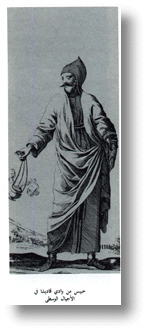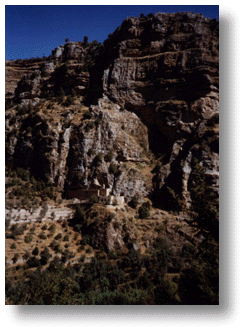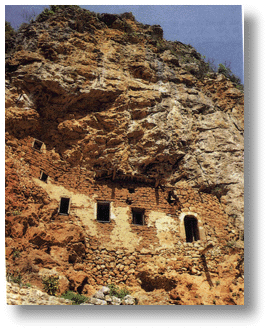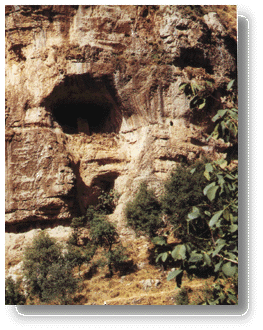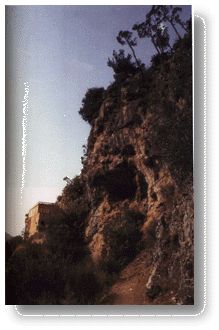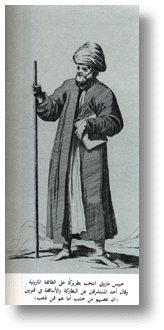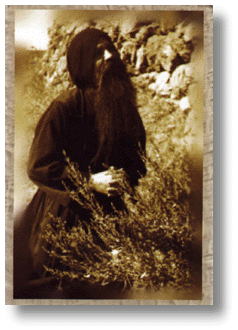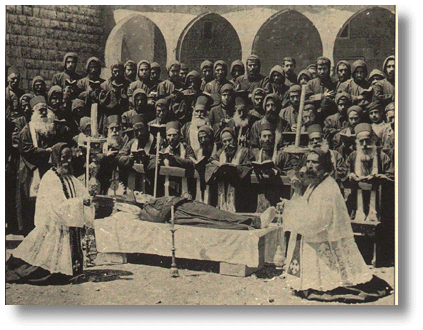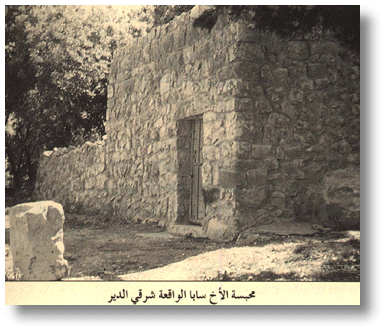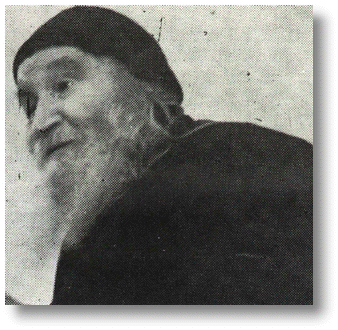From The Fourth To The Twentieth Century By Father Paul Sfeir
The lives of Maronite hermits starting with Patron Saint Maron in the Fourth Century and concluding with the present day hermits will be described in the first of this two part series. Part II will review the current way of life of Maronite hermits as the Third Millennium begins. Special acknowledgment is due Abbot Boutros Fahd, Father Cesar Al-Ashqar, Fr. Sharbel Al-Balaa and Father Hanna Al-Tayar for their assistance in research. I. INTRODUCTION
The Greek noun "eremos" means inhabitants of the desert and is the source of the English words "eremites" or "hermits". They are also called anchorites. They choose to live alone in solitude in order to avoid all contact with their fellow men. However, not all of them sought total solitude. Some had companions who were generally called students or disciples. Others performed pastoral role for people who came to visit them and live near them. Ascetic living in Syrian Christianity existed in the second and third centuries but sources are scarce and fragmented. However, it "may be traced back to the presumed Syrian origin of the Gospel according to Matthew, with its emphasis on the theme of discipleship, on a following of Christ involving celibacy (19:11-12), poverty (19:21) and homelessness (19:29) in the service of announcing the kingdom, in a proclamation to be accompanied by miraculous signs of exorcism and healing (10:7ff)" (Price 1985: XX). However, the expansion of this kind of living in ancient Syria and Asia Minor in the fourth and fifth centuries is mostly linked to the end of the Roman persecution of the Christians. Hence the end of the possibility of martyrdom. Ascetic living became second best to witnessing to Christ through martyrdom. The hermits in ancient Syria and Asia Minor were great ascetics. Some chose to live for years on the top of a pillar and were called stylites, like Saint Simon the Stylite. Others shut themselves away in one place and were called recluses like Marana and Cyra. In the early centuries of Christianity, many of those seeking Christian perfection were trained in the ascetic life by an older hermit whose way of life and Christian virtues they were expected to observe and emulate. The guide exemplified the monastic rule and the disciples were to mirror his way of life and behavior. Most hermits left no written records but their example and their deeds have survived. They had learned spirituality from the teachings of the Bible. They nourished it by partaking of the mysteries or sacraments and by emulating the virtues, heroism and sanctity of the Desert Fathers and the older hermits. To make a serious study of the monks of the Maronite Church, some of whom were leading ascetics in the early centuries of this movement, one must start with Saint Maron the Hermit and progress to Saint Sharbel in the nineteenth century. This Article treats of some most noble Maronite hermits starting with Saint Maron and his disciples who lived in the Cyrrhus region in Syria Secunda and ends with Saint Sharbel, the hermit Saint of 'Annaya, Lebanon. II. SAINT MARON, THE HERMIT FATHER OF THE MARONITES Saint Maron has been a hero of monastic life since the last part of the Fourth century. He lived "near a pagan temple which he had converted into a church", on top of a mountain in the Cyrrhus region of Syria Secunda. (Dib 1971: 3) He pursued a new way of life for a hermit that was later described as living in the open air or with nature. Such a life is "a radical form of asceticism. In the struggle between man and his human nature, ... a hermit demonstrate[s] ... mastery over human nature by ... complete subjugation of his body. This total control was achieved despite the Harshness of nature and without bodily protection, even in winter and summer" (Abou Zayd 1993: 371-372, Hourani 1997). In this new way of asceticism, Maron mortified himself and his human nature: his blanket was the sky and his bed was the ground. He went into seclusion to pray, fast, and meditate despite the summer heat and the bitter winter. People flocked to him because of his holiness and virtue; and at his hands, they begged God for physical and spiritual healing. Theodoret, the author of Saint Maron's only available biography, was
Bishop of Cyrrhus and a respected writer of his time. His book, the Historia
Religiosa (History of the Monks of Syria), is a primary source for early
Syrian monastic and ascetic life. In his book, Theodoret writes the following
about Saint Maron:
Saint Maron's feast day is February 9 in the Maronite Church. (Daher 1996: 44-45) III. THE FIRST GROUP OF MALE MARONITE HERMITS
The eminence of Saint Maron's virtues and the fame of his holiness had an effective impact on his disciples. Many have followed his example emulating his way of living and his asceticism. Theodoret wrote about a number of these disciples comparing them to plants saying: "Applying this mode of cultivation, he produced many plants of philosophy, and it was he who planted for God the garden that now flourishes in the region of Cyrrhus" (Price 1985: 118). Theodoret knew many of these hermits in person and wrote about quite a few of the famous [such] as Saint James the Hermit, Saint Limnaeus and Saint Domnina. James of Cyrrhestica, a Disciple of St. Maron James of Cyrrhestica was one of the most famous ascetics of the region of Cyrrhus. He was a companion of Saint Maron (Price 1985: 117-119). He lived briefly as a recluse and was an open-air hermit since 406 A.D. Having first spent quite some time in the company of St. Maron, James lived as a recluse for a while and then, in imitation of St. Maron, took up the life-style of open-air eremitism in 406. A. J. Festugire calls the hermits who live without shelter in the open air "hypthres" (Horn 1998). Theodoret writes:
In the Maronite Synaxarium James of Cyrrhestica is commemorated on February 20. (Daher 1996: 52-53) Limnaeus Limnaeus was first a student of Thalassius "a man adorned with many other good qualities, but surpassing the men of his time in simplicity of character, gentleness, and modesty of spirit" (Price 1985: 150). With Thalassius he lived in an area south of Tillima in the Cyrrhus region, he then became a disciple of Saint Maron and later he retreated to a hilltop above Targalla. Theodoret writes:
The Church celebrates the feast of Thalassius and Limnaeus on February 22. Theodoret also writes about John the Wonderer who ". keenly embraced this mode of life, a man conspicuous, in addition to other virtues, for gentleness and kindness. Repairing to a jagged ridge, prone to storms and northward facing, he has now spent twenty-five years there, exposed to the contrasting assaults of the atmosphere" (Price 1985: 1952). IV. THE FIRST GROUP OF FEMALE MARONITE HERMITS SSaint Maron did not only have disciples who emulated his ascetic path, but also virgin students who dispensed with the company of people and consecrated themselves to worship and austerity, in a life of seclusion and silence. Among these virgin hermits were Marana, Cyra and Domnina. Theodoret writes: "After recording the way of life of the heroic men, I think it useful to treat also of women who have contended no less if not more; for they are worthy of still greater praise, when, despite having a weaker nature, they display the same zeal as the men and free their sex from its ancestral disgrace" (Price 1985: 183). Like the male hermits, Domnina's zeal attracted many people who emulated her life as well. About two hundred and fifty women formed her community of disciples. (Price 1985: 187). Women's asceticism was prospering in Egypt, Palestine, Asia and other places (Brock 1987:9) when Theodoret wrote about the lives of Marana, Cyra and Domnina. Theodoret recorded the biographies of 33 hermits, thirty of whom where men and three were women. It is noteworthy that the only women referred to in Theodoret's book were all students of Saint Maron. Marana and Cyra
Their feast day in the Maronite Church is on the 28th of February. (Dagher 1996: 59-60) Domnina
The Maronite Church celebrates the feast of Saint Domnina on the 1st of March. (Daher 1996: 61) V. FROM APAMEA TO THE HOLY VALLEY OF SAINTS, QADISHA After the Maronites settled in Lebanon with their brethren in the areas of the Jubbat, the Qadisha Valley, Qozhaya, and Qannoubine in the Northern part of Lebanon, their community flourished with hermits and ascetics. Many retreated to the natural caves and hermitages, especially of the Qadisha Valley. "Soon monasteries multiplied on the hills, hermits populated the flanks of the mountains, perched on overhanging rocks or nestled in caves." (De La Rogue 1722: 57-59).
The [Qadisha] Valley with its natural serenity and ruggedness offered these hermits and recluses an ideal setting for their contemplation, asceticism and prayers. "Transplanted into a land particularly favorable to recollection and meditation, monastic life flourished with a new vigor" (De La Roque 1722: 57-59). The Valley flourished because of them and was called after them -- Qadisha from Syriac meaning saints, Qannoubine from Greek meaning the gathering of monks, and Qozhaya from Syriac meaning the treasure of life. Historic references about the Maronite hermits in the Holy Valley of Qadisha is scarce. There may be two major reasons for this lack. First, the obscure and invisible life in which the hermits lived; and second, the persecutions, conflicts, the burning of libraries and the plundering of monasteries and hermitages which left us practically no writings about these hermits. Most of what we know about the eremitic life in the Maronite community comes mainly from the writings of the Patriarch Scholar Stephen Douaihi in his book "The History Of Times" (Tarikh al Azminat). The first hermit that Douaihi mentions is Youhanna from Qnat in Northern Lebanon.
Douaihi recounts that Youhanna became a hermit in 1228 in the Qannoubine Valley (Vat. Syr. No 215 1680: 53). He then mentions that in 1393, Elisha' Al-Hadthy was living in Mar Sarkis (Saint Sergius) Hermitage near the Monastery of Mar Aboun (Saint John Maron) overlooking the Holy Valley (Vat. Syr. No 215 1680: 86). Douaihi states that "when the Patriarch Youhanna Al-Jaji died in 1445, the bishops, the superiors of the monasteries and the people elected a successor Bishop Ya'coub son of Eid Al-Hadthy who was raised in Mar Sarkis (Saint Sergius) Hermitage" (Vat. Syr. No 215 1680: 93). In 1472 The priest Girgis Al-Ehdeny was living with his student Deacon Tadrous from 'Aintourine in Saint Anthony of Qozhaya hermitage. (Vat. Syr. No 215 1680: 96) He tells that in 1495 the priest Barakat from Bkoufa built the hermitage of Mar Mikhael (Saint Michael) north-west the Monastery of Qozhaya and lived in it until his last days and that the following hermits succeeded each other in living in this hermitage: Moussa from Yammouneh, Ya'coub from Barnasa near Mayfouq, Michael I from Ehden, Hanna from Ehden, Michael II and his nephew Gibrayel from Ehden, then Michael III from Ehden who died in 1617. All of these names were written in the Bible of the said hermitage. (Vat. Syr. No 215 1680: 99) For the Sixteenth Century, Douaihi mentions the names of the hermit Younan Al-Matriti who spent 50 years in the hermitage. His student, hermit Gibrayel Al-Ehdeny, wrote the following about him which is related to us by Douaihi "In the year 1542, the pious hermit Younan Al-Matriti died in a holy manner, fortified with the blessing of the Patriarch Moussa and of Koriakos, Bishop of Ehden. He had lived in the hermitage of Mar Mikhael (Saint Michael a hermitage at the entrance of the Monastery of Qozhaya) for 50 years. With perfect purity of heart, he celebrated Mass each morning; four years before his death, he ate only once every two days, and during Lent, on Saturday and Sunday only. His fasts extended from Pentecost to Christmas, from Epiphany to Easter. He drank only on Saturday and made prostrations until he was covered with sweat; during Holy Week he did 24,000 and was surpassed only by his more vigorous student Hanna Al- Lahfedi who had gone up to 26,000" (Dib 1971: 214-215, Vat. Syr. No 215 1680: 111, Goudard 1908: 297) The hermit Younan had many students, but most famous of all was Youhanna Al-Lehfedy who served his sick teacher for 14 years. This student surpassed his teacher in ascetic living. (Vat. Syr. No 215 1680: 112) Also Gibrayel Al-Ehdeny, who was an austere living man, surpassed his colleagues in penance, fasting and severe asceticism. He made prostrations a thousand times and during Holy Week he would not stop his prostrations. He abstained from water from the first day of lent until the [Maundy] Thursday of the Mysteries Despite these ascetic actions, he never stopped copying books and manuscripts, until all of Mount Lebanon was filled with his beautiful hand copied books. (Vat. Syr. No 215 1680: 113) In addition, Douaihi mentions the death in1560 of the Hermit Melka Al-Bqoufani who spent 60 years as a hermit. He first lived in the hermitage of Qozhaya, then at Mar Doumit in Daraya, then in a hew hermitage opposite of 'Argis and lastly in Mar MiKhael (Saint Michael) hermitage above Qozhaya Monastery. He was an excellent model and a living example to all. He would kneel during lent for a week at a time and he would not eat but on Sunday. He went barefoot and would mortify his body through hunger, thirst and lack of sleep. He always invoked the name of the Lord. He never looked at a woman's face. Because of his virtues and saintly conduct, Patriarch Moussa Al-'Akkary elevated him to Bishop. (Vat. Syr. No 215 1680: 114) Upon his official visit to the Maronite Nation as an envoy of Pope Clement VIII in 1656, Jerome Dandini wrote: "I am sure that these hermits are the only ones left from those ancient ascetics who used to isolate themselves from people to live in deserts and in the mountains of Syria and Palestine. Their homeland in this Valley does not fall in beautiful plains and in superb mountain slopes overlooking fascinating panorama, and does not fall in a place hustled [hustling] with people, but rather they penetrate the most solitary of all places, they climb the mountains farthest from society, as to live under the protruding and towering rocks, they live in grottos and caves which are closer to lairs and dens than to human habitation." (Dandini 1685: 222) The reputation of these and many other hermits and monks went beyond Syria and Lebanon to attract Frenchmen such as François de Gallaup, Sir de Chasteuil from Provence who came in the first part of the seventeenth century. He first lived in a room in Mar Ya'coub Monastery (Saint Jacob) in Ehden. Next he stayed in the Monastery of Mar Sarkis (Saint Sergius) in Ras el-Nahr, and then in the Monastery of Mar Lisha' (Saint Elisée) in the Holy Valley. He lived according to the rules, under the direction of the monks. He spent 12 years in solitary prayer, meditation, the performance of penance and reading Holy Scripture in various Semitic languages. He died in 1644.
In 1668, de Gallaup was succeeded by four other Frenchmen who werelooking for a life of solitude and austerity in the hermitages of the Valley ofQadisha and Qannoubine. Patriarch Girgis Al-Bseba'li agreed to theirrequest and accepted them among the Maronite hermits. Some chose to livein the Hermitage of Mar Shallita (Saint Arthème) near Kfarsaroun; others inthe Hermitage of Saint Anthony which is carved in rock, near the Monasteryof Qannoubine; and yet others in the Hermitage of Mar Aboun (Saint JohnMaron) near Hadath [al-Jubbah]. (Vat. Syr. No 215 1680: 143, 152) More hermitages were established toward the second half of theseventeenth century as the number of hermits increased in the QadishaValley and Qannoubine. Duwaihi describes Hermit Sarkis Al-Samarani,who became a solitary or religious recluse in the Hermitage of SaintAnthony of Qozhaya, as a religious and learned man and one with excellentcommand of Syriac and Arabic. (Vat. Syr. No 215 1680: 135) ThenDuwaihi identifies Yousef Al-Basloukaiti who died in 1580, and Ja'coub'Assas Al-Samarani who died in 1584, as hermits in the hermitages ofFaradis. (Vat. Syr. No 215 1680: 120) Duwaihi continues by naming Hermit Sarkis Ben Moussa Al-Rizzi - who after completion of his studies in Rome, return to Lebanon and upon the election of his brother Youssef as the Patriarch in 1596 -- took his place in the Hermitage of Mar Bishoy (Saint Païsios) near the Monastery of Saint Anthony of Qozhaya. It is noteworthy that the first printing press in the East was brought to the Monastery o Saint Anthony of Qozhaya through the efforts of Hermit Sarkis Al-Rizzi. (Vat. Syr. No 215 1680: 141) Though one thinks mainly of men as hermits, there have been women hermits as we have seen with the disciples of Saint Maron. "In the past, nuns have practiced the solitary or cenobitic life. Stephan 'Awouad Assemani reported that, after a certain time in religious life, those who requested would be given a cell located near the monastery where they would remain cloistered until death. Assemani refers to a note, written by Patriarch Jeremia Al-'Amshiti, which recorded November 6, 1199 as the date of death of a nun who had become hermit." (Dib 1971: 223). This note is written [in the margin] in the Rabbula Gospel, preserved at the Medicaean-Laurentian Library in Florence, Italy. (Dagher 1988: 24) In his chronicle, Duwaihi reports that in the year 1533, the solitary, Father Girgis Ben Hirwas of the village of 'Argis, devoted his time to the construction and expansion of the Monastery of Mar Lisha' (Saint Elisée). Hanna 'Abd al-Mun'em helped him in his enterprise. The nun Sarah, who was living a solitary life and who endured the rigors of ascetic life like him, also contributed to the cost of the monastery's construction. (Sfeir 1986: 109-110) Assemani wrote in 1742 that besides cenobitic nuns, whose monasteries in the Orient are still seen today, there once existed another type of nuns referred to as recluses. (Sfeir 1986: 111-112) Father Eugene Roger, who visited Lebanon in the first half of the seventeenth century, "encountered among the old religious a nun who had previously led a solitary life. Some were still to be found at the beginning of the eighteenth century" (Dib 1971: 224). Though these saintly men have renounced the world, they remain subject to the authority of the Church. In critical times and at the command of the Church, they emerge from their solitude or cenobitic life, like fresh reserve forces, to manage its affairs or to strengthen the disheartened of its spiritual flock. From among the hermits of the Qadisha Valley, Qozhaya and Qannoubine, bishops and patriarchs were elected to serve the Maronite Nation. Under the vow of obedience to the Church, three well known hermits were obliged to leave their retirement [from the world] to manage the affairs of the Maronites. They were Mikhael Al-Rizzi (1567-1581), Sarkis Al-Rizzi (1581-1597), Youssef Al-Rizzi (1597-1608). (Vat. Syr. No 215 1680: 115, 119) Toward the end of the seventeenth century, monastic life began to be more organized with a common rule as in the West. The hermitic life in the Maronite church continued to prosper but now it was organized and regulated by established monastic rules. VI. EREMITIC LIFE UNDER RESTRUCTURED MONASTIC RULE Prior to 1695, there was no monastic or eremitic organization in the modern legal sense. Monastic life in the Maronite community was organized as such in 1695, the date of the restructuring of the independent monasteries in Lebanon under one religious order. "Three Maronites from Aleppo helped him [Patriarch Duwaihi] to realize his desire [i.e., to introduce in the monasteries the system of religious orders of the West]: Gabriel Hawa (later Archbishop of Cyprus), Abdallah Qaraali (later Archbishop of Beirut), and Joseph el-Bethn" (Dib 1971: 217).
Under Duwaihi's auspices, the three Maronites Aleppines (referring to Aleppo in Syria) undertook the challenge of reform. They drew up their plan and "received from his hands the monastic habit and cowl on November 10, 1695. In 1698, when they had completed drawing up the statues, their institute already counted many new recruits. They called themselves at first the Aleppine monks, from the name of the town of their founders Aleppo. Then in 1706 they called themselves the Lebanese monks of Saint Anthony, in memory of the country in which the Order was founded." (Dib 1971: 217). The monks without exception pronounced vows of poverty, chastity, obedience and humility. It should be noted here that in 1770, this Order was then divided into two organizations: the Lebanese Maronite Order (The Baladite Order) and the Aleppine Order which was renamed the Lebanese Mariamite in 1969. (Dib 1971: 219). The majority of the autonomous monasteries united under the new rule and thereby became part of the new order. This organizational change did not disrupt the tradition of eremitic living. In fact "in these monasteries, the monks were divided into three categories: lay brothers, priests and hermits" (Dib 1971: 221). Some monasteries had isolated cells or hermitages close by, where those religious who felt the call to solitary living could retire with the permission of the superior and under the aegis of his guidance and the rule of the order. "According to the old constitutions, after five years of profession and with the permission of the abbot, the hermit is permitted to retire temporarily or perpetually into a cell separated from the community, to devote himself to prayer and spiritual exercises. This cell is his cloister. The solitary should cultivate the field which adjoins his hermitage or do other useful manual works' (Dib 1971: 222). Even when living in solitude, the hermit remains a member of the monastic community, obedient to his superior should he be asked to resume monastic life. VII. HERMITS OF THE MARONITE MARIAMITE (ALEPPINE) ORDER After the reconstitution of the Maronite monastic life which was led by Father Abdallah Qaraali and company in 1695, eremitic tradition flourished in new and old hermitages. The Maronite Mariamite (Aleppine) Order continued to experience this great oriental tradition, especially in its most important hermitage of the Monastery of Saints Peter and Paul at Kraim-El-Teen in Beit Chabab. This monastery was donated to the Order by Bishop Youhanna Habkouk in 1712. The Order then demolished the old structure and built a new one in 1718 to house 20 monks. As for the hermitage, it is believed to have been built in 1725 in the name of the Blessed Mother and Mar Roukouz (Saint Rock). (Fahed 1994: 14) Seven monks were hermits in this hermitage from 1730 to 1926 and observed a life of silence, fasting, prayer, and contemplation. They were Antonios Al-Bathawi (Moubarak) (+1740); Ephrem Basili Al-Ehdnani (+1782); Hananiya Al-Klay'ati (+1748); Laurencius Haymari Al-Dirani (+1880), who was the Superior of the Order's monastery of Saint Anthony the Great in Rome and resigned his duties to become a hermit; Moubarak Al-'Almawi (+1889); 'Abd El-Masih Karam Al-Hayek Al-Chababi (+1917); and Sirabion Al-'Akkari (+1926), who was the last to have occupied this hermitage. (Fahed 1994: 14-16)
The Old Monastery of Mar Lisha' (Saint Elisée) in the Qadisha Valley existed prior to 1315. It is not known when or by whom it was built. The monastery consists of a grotto with a constructed façade. It was given to the Order in 1698. We know little about the hermits who lived there. However, two of those identified are the French hermit François de Chasteuil who spent the last part of his life in this monastery and was buried in it in 1644; and Father Antoine Tarabay Al-Tannoury who lived in it for twenty five years and was transferred for health reasons to Christ the King Monastery in the Zouk where he lived until his death in 1998. Hermit Al-Tannoury was buried in the monastery. (Fahed 1979: 18, 25) He is the last hermit of this Order. Hermits Antoine Al-Dlebtawi (+1725) and Maroun Al-Haklani (+1756) lived, died and were buried in the hermitage of Saint Anthony of Qozhaya. Other hermits of this Order are Suleiman Al-Shanan'iri (+1707), Basil Al-Ehdni (+?), 'Abdallah Al-Bsherrani (+1706), Hanna Al-Bani (+1706), Hananiya Al-Hayek (+1780), and Eklimos Al-Zeghrini (+1881). VIII. HERMITS OF THE LEBANESE ANTONINE ORDER The Lebanese Antonine Order was founded in 1700 by Bishop Gebrayel Al-Blouzani, Bishop of Aleppo (1663-1704) and later Patriarch of the Maronites (1704-1705). (Abi Khalil 1996: 106-107) Four hermitages were centers of eremitic life in the past three centuries. They were in Mar 'Abda in Naher Al-Kalb, Saints Peter and Paul in the Kattine, Mar Cha'aya (Saint Isaïe) in Broumana, and Mar Sarkis and Bacchus (Saints Sergius and Bacchus) in Ehden. (See Al-B'ebdati 1999) Mar 'Abda (Saint Abdon) Monastery in Naher Al-Kalb was renovated by Patriarch Stephen Duwaihi in 1685. (Al-B'ebdati 1999: 171) The Order received it in the early part of the eighteenth century, most probably between 1712-1722. The monastery's hermitage was built between 1785 and 1789. The first hermit to have occupied it was Moubarak A-Shoufi Silfaya (+1770). He was followed by Youhanna Al-G'itawi (+1779), Wahbeh Al-Hage Boutros (+1867), Cerabion Al-Chemali (+1888), Youhanna Al-Hayek (+1888) and Germanos Elia Al-Dernani (1890),. (Al-B'ebdati 1999: 171-172, 179-180 and Dalil Ruhbani 1999: 6, see also Al-Balaa 1999) The Monastery of Saints Peter and Paul in the Kattine, Gezzine was granted to the Order in 1760. The hermitage was occupied for a short period by Genadios Al-Kahwaji Al-Bkasini and then by Keriakos Al-Samarani (+1843) and Germanos Elia Al-Dernani who when his relatives kept visiting him asked that he be permitted to move to the hermitage of Mar 'Abda (Saint Abdon) where he died in 1890. (Al-B'ebdati 1999: 294, Dalil Ruhbani 1999: 6, see also Al-Balaa 1999) The Monastery of Mar Sarkis and Bacchus (Saint Sergius and Bacchus) was given to the Order in 1739. Germanos Al-Ehdni is the only hermit known to have lived in this monastery's hermitage (1890). (Dalil Ruhbani 1999: 7, see also Al-Balaa 1999)
The Monastery of Mar Cha'aya (Saint Isaïe) was in existence before the dawn of the eighteenth century when the Order received it. In the hermitage of this monastery lived and died a famous hermit named Saba Nasrallah who was granted permission to live a solitary life in 1883. He died in 1900 and was the last hermit of this Order. (Dalil Ruhbani 1999: 7, Al-'Akary 1998: 208-217, see Al-Balaa 1999) A new hermitage is built to the north of this monastery at the request of the Petits Frères de Jésus and the approval of the Order for seclusion, prayer and contemplation of their members for a few days before they return to their mission. This hermitage was inaugurated in 1970. (Al-'Akary 1998: 222-223) IX. HERMITS OF THE LEBANESE MARONITE ORDER (THE BALADITE) The main hermitages of the Lebanese Maronite Order were those belonging to the Monasteries of Qozhaya, Houb, 'Annaya, Mayfouq, Qottara, Mashmousheh, and Our Lady of Tamish. The calendar of each of these monasteries lists the names and provides brief biographies of those who became hermits. There isn't enough space in this article to mention all of them. However we will mention the names of those who became hermits in the monasteries of Qozhaya and Tamish because we still find resident hermits in them. We will also mention the hermits of the hermitage of the Monastery of 'Annaya because of Saint Sharbel. Without doubt, the Monastery of Qozhaya ranks among the most important monasteries, especially in regard to its hermitages, Mar Bishoy (Saint Païsios), Mar Boula (Saint Paul of Thebes), Mar Mikhael (Saint Michael), and Mar Semaan (Saint Simon), as well as its hermits, especially those who became Patriarchs, Moussa -Al-'Akkari (1524-1567), Mikhael Al-Rizzi (1567-1581), Sarkis Al-Rizzi (1581-1597), Youssef Al-Rizzi (1597-1608), and Youhanna Makhlouf (1608-1633).
In 1716, Abdallah Qaraali built a hermitage in Ghobta, west of the Monastery of Qozhaya and named it Mar Boula (Saint Paul of Thebes) Hermitage. Antonios the Son of Moubarak and the Son of Chouchan (no first name available) became hermits here. However, the first name inscribed in the calendar of the monastery was Father Antonious Al-Bani who died in 1725. The calendar also lists the Brother Maroun Al-Hakli (+1756), Father Naphitos Basbous (+1784), Father Ephrem from Mazra'at KfarDbian (+1801), Father Makarios Al-Agaltouni (+1807), Father Lisha' Al-Ma'adi (+1819), Father Moubarak Abou Hathem Al-'Ainqoudi (+1821), Father Spiridon Al-Zouki (+1829), Father Antonios Al-Habis (+1829), Father Zakariya Al-Bkasini (+1842), Father Francis Fakhry al-Bsherrawi (+1855), Father Antonios Al-Sghabi (+1856), Father Abdallah Al-Bsherrawi (+1857), Father Gibrayel Al-Chababi (+1864), Father Augustine Al-Bsherrawi (+1884), Father Abdallah 'Awad (+1892), Father Daniel Al-Bsherrawi (+1895), Father Maroun Al-Sera'li (+1898), Father Saroufim Knaywir (+1907), Father Mourkos Al-Kitawi (+1912), Brother Martinos Kfour Al-'Arbat (+1912), Father Antonios from Toula in the Joubet (+?), Father Michael Al-Hasrouni (+1924), Father Bernardos Al-Asmar from Jizzine (+1950), Father Youssef Farah (was martyred in the Monastery of Jannine in 1976 during the war in Lebanon ), and Father Antonios Chayna who entered the hermitage in 1982 and remains the resident hermit. (Dagher 1988: 56-69)
The Monastery of Our Lady of Tamish was built in 1673 on the ruins of the Temple of Artémis. The hermitage was erected in 1926. The first known hermit at the hermitage was Father Ya'coub Abi Maroun from Mazraat Al-Chouf. He remained there from 1926 until his death in 1958. Today, Father Youhanna Khawand is the resident hermit of this hermitage. (Dagher 1988: 144-146) Saint Peter and Paul hermitage of 'Annaya was built in 1812. Among the who lived in it was Father Elish'a Al-Hardini, the brother of the Blessed Nematullah Al-Hardini (Beatified by Pope John Paul II on May 10, 1998). This hermit was succeeded by Father Sharbel Makhlouf, who was born Joseph Makhlouf in 1828 in Beqa-Kafra. At the age of twenty-three, Sharbel (the name he chose when entering the Novitiate) left his loving family and entered the Lebanese-Maronite Monastery of Notre-Dame de Mayfouk. Following studies and perpetual profession at Saints Cyprian and Justine in Kfifan he was ordained priest in 1859. He was then transferred to Saint Maron's Monastery in 'Annaya where he spent sixteen years as a monk. In 1875, he was permitted by his superior to enter the hermitage. He spent 23 years as a hermit, living in solitude, observing his religious and priestly and monastic vows in a heroic way. He spent his time in meditation, contemplation, continuous prayer, mortification and penance, manual labor, and fasting. He would prostrate himself in the presence of the Holy Eucharist. He wore a hair shirt and slept on the floor with a log as his pillow. He was known for his austerity, obedience and chastity. He died at the hermitage in 1898. His body was found to be incorrupt and miracles were attributed to his intercession. He was beatified in 1965 and canonized in 1977. (Hourani 1989) After Saint Sharbel died, his companion and brother priest, Father Makarios Al-Meshmeshani, continued his own life as a hermit until his death in 1914. He was succeeded by Father Antonios Al-Ghalbouni, Father Antonios Al-Hsarati (+1944), Brother Boutros al-Meshmeshani (+1924), Brother Michael Al-Tannouri (+1901), Father Antonios Qozhaya (+1958), Father Elias Abi Ramia Al-Ehmaji (+1967). (Dagher 1988: 96-137) Many monks, not mentioned for lack of space, were permitted to live as hermits for few years. Some of them entered the hermitage and withdrew. CONCLUSION These pious hermits strove and others continue to strive for union with God through solitary life, austere existence, and their spiritual and pastoral ministry to the pilgrim visitors. Their lives of prayer, abstinence, their assumption of others' troubles, their retreat from the world into the solitude of grottos, rock-hewn shelters, caves, and hermitages did not insulate them from the concerns and sufferings of their fellow man. On the contrary, their awareness was heightened. The days and nights of these hermits were spent in prayer and chanting, meditation, penance, and physical labor to achieve a close bond with God for their own salvation and that of the world. During the canonization of Saint Sharbel, His Holiness Pope Paul VI affirmed that "this type of sanctity practiced by Saint Sharbel Makhlouf is of great value, not only for the glory of God, but for the vitality of the Church. For as we have many members in one body, as Saint Paul said (Romans 12: 4-8), but all the members do not have the same function. So we , being many, are one body in Christ and individually member of one another. Having then gifts differing according to the grace that is given to us, let us use them: if prophecy, let us prophesy in proportion to our faith; Or ministry, let us use it in our ministering; he who teaches in teaching; he who exhorts, in exhortation; he who gives with liberality; he who leads, with diligence, he who shows mercy with cheerfulness." (Sfeir 1986: 229) The Maronite Church remains true to its Syriac heritage and continues to give the Universal Church hermits who use the grace given to them. Even at the dawn of the Third Millennium, this Syriac spirituality and tradition remains alive and continues through two Maronite hermits from the Lebanese Maronite Order of monks. Father Antonios Chayna at Mar Boula Hermitage of the Monastery of Saint Anthony of Qozhaya in the Holy Valley of Saints north of Lebanon and Father Youhanna Khawand at the hermitage of Our Lady of Tamish (Artemis) Monastery in the Maten area of Lebanon. These two hermits are not only assuring themselves of personal salvation but through their ceaseless prayer, their rejection of earthly goods, their life of total renunciation, and their pastoral ministrations are bridging the gap between men and God and assuring people that God's salvation is also available to them without themselves becoming ascetics. Bibliography Abi Khalil, C. Al-Batriyark Gebrayel Al-Blouzani (1630-1705) (The Patriarch Gebrayel Al-Blouzani (1630-1705), Arabic Press: Beirut, 1996. AbouZayd, S. Ihidayutha: A study of the Life of Singleness in the Syrian Orient: From Ignatius of Antioch to Chalcedon 451 A.D. Oxford, 1993. Al-Akary, A. Deir Mar Asha'ya (The Monastery of Mar Asha'ya), Beirut, 1998. Al-Balaa, C. Al-Ruban Al-Antounioun (The Antonine Monks), Beirut, 1999. Al-B'ebdati, E. Tarikh Al-Ruhbaniyat Al-Antoniyat Al-Marouniyat, Chemali & Chemali: Beirut, Second Edition, 1999. Al-Khoury Al-'Aramouni, Y. Al-Antonioun 'Abr Al-Tarikh, Majalat Hayatuna Al-Antoniyat 1966: 1-11. Al-Mas'oudi. Book of Warning and Revision (Kitab al-Tanbih wal-Ischraf), edited by M.J. de Goeje, Leyden, 1894. Brock, S. and Ashbrook Harvey, S. Holy Women of the Syrian Orient, California, 1987. Chronicle of Michael the Syrian, 2 vols., ed. Chabot, Paris, 1901. Dagher, L. Kashf Al-Khafa 'An Mahabes Loubnan Wa Al-Houbasa, (Unveiling the Mystery of the Hermitages and Hermits of Lebanon) Lebanon, 1988. Dalil Ruhbani: Al-Ruhbaniyat Al-Antoniyat Al-Marouniyat, Beirut, 1998-1999. Dandini, D. Missione Apostolica al Patriarca e Maroniti del Monte Libane, e sua Pellegrinazione a Gierusalemme, Cesena, 1656. Dau, B. Religious, Cultural and Political History of the Maronites, Lebanon, 1984. Duwaihi, E. History of Times (Tarikh al Azminat), Edited by Boutros Fahed, Lahed Khater Publications, 1982. Fahed, B. Tarikh Dairay Mar Boutros Kraim-el-Teen Beit Chabab wa Mar Elias Shwaya Dhour-el-Chwouair. (History of the Monasteries of Boutros Kraim-el-Teen Beit Chabab and Mar Elias Shwaya Dhour-el-Chwouair.), Cairo, 1994. Fahed, B. Al-Moujaz Al-Tarikhy (Historic Summary), Kreim Mondern Press: Jounieh, 1979. Horn, C. "James of Cyrrhestica, a Disciple of St. Maron," Journal of Maronite Studies [http://www.maroniteinstitute.org/jms/january98] Vol. 2, no. 1 (1998). Horn, C. "Reaping Much Benefit From Saint Maron's Teachings: Limnaeus and his Teacher Thalassius," Journal of Maronite Studies [http://www.maroniteinstitute.org/jms/january98] Vol. 2, no. 2 (1998). Horn, C. "The Correspondence Between the Monks of Syria Secunda and Pope Hormisdas in 517/518 A.D.," Journal of Maronite Studies [http://www.maroniteinstitute.org/jms/Oct97] Vol. 1, no. 4 (1998). Hourani, G. "Domnina: A Female Disciple of Saint Maron," Journal of Maronite Studies [http://www.maroniteinstitute.org/jms/april97] Vol. 1, no. 4 (1997). Hourani, G. "Historical Documents and Manuscripts: Saint Maron's Relic," Journal of Maronite Studies [http://www.maroniteinstitute.org/jms/january97] Vol. 1, no. 1 (1997). Leroy, J. Les Manuscrits Syriaques A peintures Conservés dans les Bibliothèques D'Europe et d'Orient, Paris, 1964. Ms. Syr. 203. Manuscript 203 contains the Ten Chapters of Thomas of Kaphartab. Bibliothèque Nationale de Paris. Naaman, P. The Maronity: Theology and Life, from the Mountains of Cyrrhus to the Plains of Apamea, (Al Marouniyat Lahout wa Hayat, Min Gibal Qorash Ila Souhoul Aphamea), Kaslik, Lebanon, 1992. Sfeir, B. Les Ermites dans L'Église Maronite. Université Saint-Esprit: Kaslik, 1986. Price, R. M. Theodoret of Cyr: A History of the Monks of Syria. Translated. Michigan, 1985. Wright, W. Catalogue of Syriac Manuscripts in the British Museum, London, 1870-1872. |
